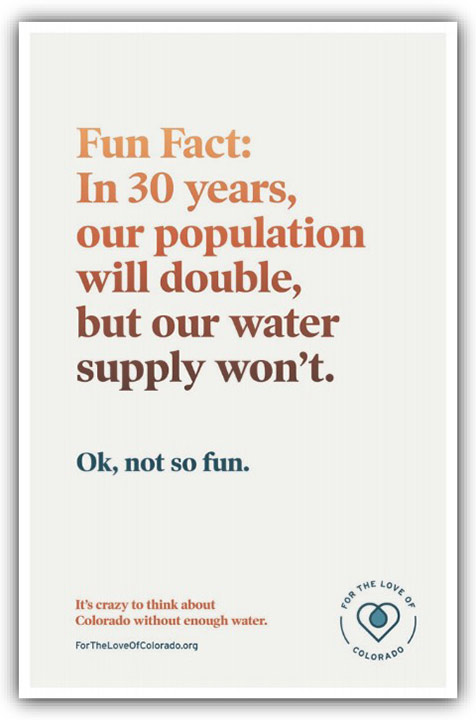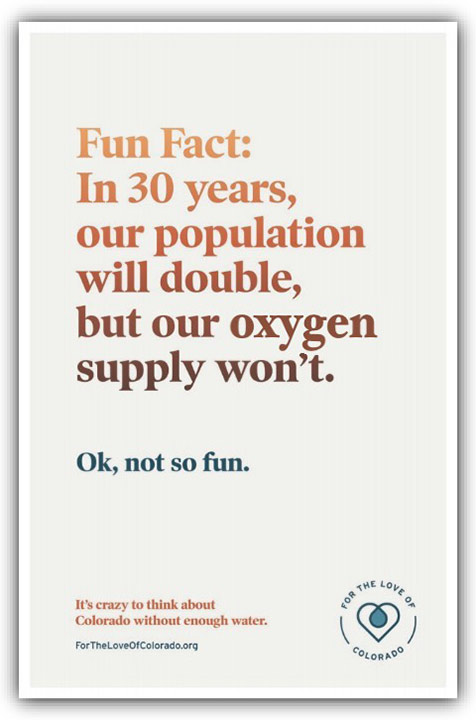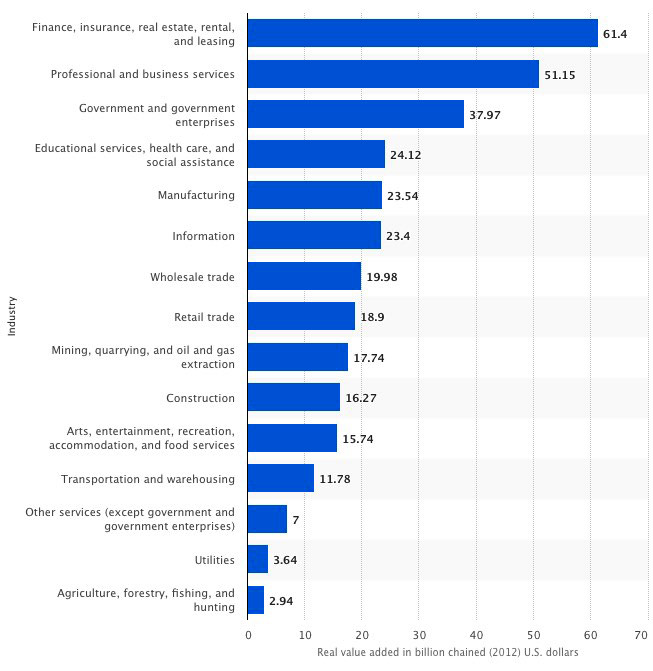Daily Post readers might find the ‘For the Love of Colorado’ advertising campaign to be somewhat alarming. Or you might find it mildly amusing, depending on your faith that people can find sensible solutions to challenging problems. You might even find the advertising campaign annoying, depending upon your tolerance for political spin.
For example. The following message, you might find to be alarming… or amusing… or annoying.
Reasons exist to find the message alarming. Historical trends and archeological research certainly suggest that the average amount of rainfall and snowfall in Colorado, over the next 30 years, is not likely to increase. Some scientists even suggest a decline in precipitation between now and 2050. And populations trends over the past 100 years suggest a measurable increase in Colorado’s population will take place over the next three decades, assuming that Colorado isn’t transformed into a waterless desert during that period.
I will be the first to admit, facts ain’t what they used to be. For one thing, a prediction about the future can never be a “fact”; it can only be a prediction. (In our current political climate, even facts about what is happening right now often have little connection to reality.) Predictions about the year 2050 are virtually guaranteed to be wrong, to one degree or another.
According to the US Census, the population of Colorado increased by about 41 percent during the 30-year period from 1920 to 1950. Between 1950 and 1980, another 30-year period, the state’s population more than doubled. And from 1980 through 2010, yet another 30-year period, the increase was about 66 percent, putting us at almost exactly 5 million residents in 2010.
If the increase between 2010 and 2019 had been around 30 percent, then we might feel comfortable predicting that Colorado’s population would double in the 30-year period between now and 2050. But in fact, the increase since 2010 was only about 14 percent — a trend that suggests Colorado’s population will increase by less than 50 percent by 2050.
There’s another reason, for folks with a sense of humor, to smile at ‘For the Love of Colorado’ campaign messages.
Here’s a slightly different wording of the same poster:
Yes, it’s a “Fun Fact” that — just like our water supply — the amount of oxygen available to Coloradans will likely remain the same, no matter how our population grows. The same goes for the amount of arable land, in the sense that land suitable for growing crops (whether it’s converted into suburban subdivisions or used for agriculture) will likely remain the same between now and 2050. There are indeed certain resources that do not increase when population increases.
One thing that might increase, however — if the ‘For the Love of Colorado’ coalition has anything to say about it — will be the amount of taxes and fees spent on the Colorado Water Plan.
But throwing money at the problem of “water supply” might not be the best solution for Colorado, in spite of what organizations like the Denver Metro Chamber, Denver Water, the Colorado Cattlemen’s Association, and the Walton Family Foundation would have you believe.
And since we’ve touched on the subject of arable land — land suitable for growing food — let’s dig a bit deeper into that damp, fertile soil.
Here are some fun facts, that might actually be facts. (Bear in mind, however, that some of these facts were derived from federal government sources.) The Colorado economy is dependent upon: a large number of industries, vast areas of undeveloped land, myriad government agencies of all types, and a wide range of lifestyle choices. The authors of the Colorado Water Plan acknowledged some of those components in that 2015 plan…
…Colorado is composed of vibrant and sustainable cities, viable and productive agriculture, a robust recreation and tourism industry, and a thriving natural environment…
As far as the ‘money economy’ is concerned, we can measure the importance of various sectors by their ‘real value’ contributions to Colorado’s GDP (Gross Domestic Product). Here’s one graphic interpretation of the state’s 2018 economy in terms of GDP:
This chart suggests that the total annual value contributed to the Colorado economy by its various industry sectors amounts to somewhere in the $312 billion range.
Let’s glance at that Colorado Water Plan statement once again:
…Colorado is composed of vibrant and sustainable cities, viable and productive agriculture, a robust recreation and tourism industry, and a thriving natural environment…
We understand and agree that Colorado benefits from a thriving natural environment — at least the parts of the natural environment that have not yet suffered from the encroachments of industry and residential and commercial development.
And yes, the cities seem vibrant enough, and perhaps they’re sustainable.
Can we talk about “viable, productive agriculture” for a moment? According to the chart shown above, “Agriculture, forestry, fishing, and hunting” taken together contributed about 1 percent of the ‘real value’ in the Colorado economy, in 2018. About $3 billion, in a $312 billion economy.
The US Geological Survey posts information it believes to be factual, about water use in America. According to their 2015 data (if I’m reading their charts accurately) all public uses of water in Colorado amounted to about 308 billion gallons of water. That includes residential, government, industrial, and power generation uses. Mining, oil and gas used another 12 billion gallons. Thus, it would appear from a glance at the GDP chart above, that 99 percent of Colorado’s economy accounted for about 320 billion gallons of water use, in 2015.
Our state’s agriculture sector was no doubt viable and productive in 2015. And well it should be, since our farmers and ranchers used about 3,300 billion gallons of water that year. 3.3 trillion gallons.
If the USGS data is correct, and if I’m reading the tables correctly, one percent of Colorado’s economy — our viable, productive agriculture — was responsible for 92 percent of our water use in 2015.
Obviously, the best way for Colorado to solve its water supply problem, if we truly have such a problem, is for everyone to stop eating food.




